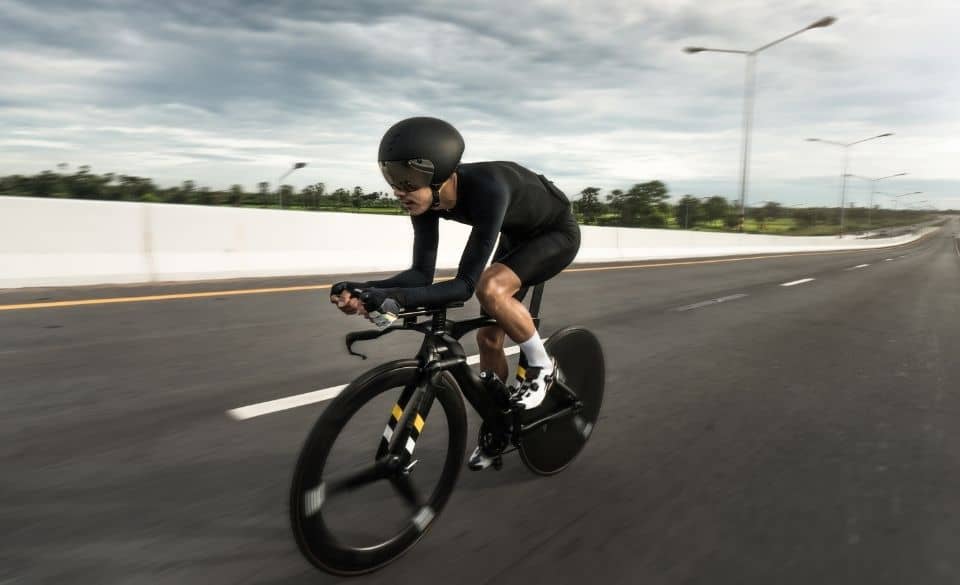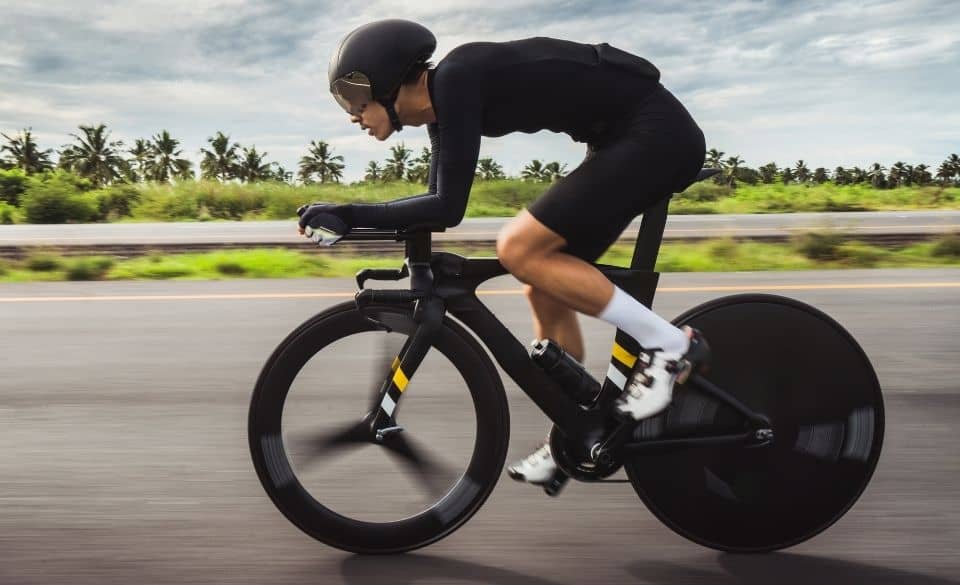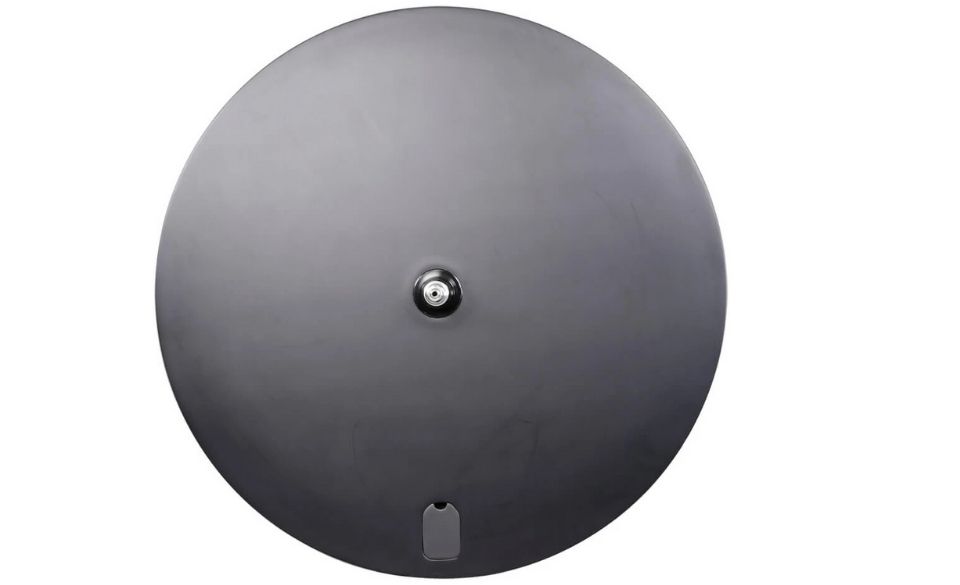
Disc Wheel Aerodynamics – Disc wheel vs Deep Section for Time Trials
Page Contents
Disc wheels became popular in 1984 after legendary cyclist Francesco Moser smashed the world record. This was the first time he had used disc wheels on the front and rear of his bike. Realizing disc wheels provided an aerodynamic advantage, triathletes then took advantage of this and used them in competitions such as Ironman. Since then, they have become widely adopted in both cycling and triathlon.
However, after Moser first made disc wheels famous, aerodynamics and weight have improved. Because of this, more cyclists and triathletes are using disc wheels to improve their aerodynamics and speed.
Today, the disc wheel has become a mainstay with athletes looking to improve their speed. Unfortunately, the Union Cycliste Internationale has banned front and rear disc wheels. So no professional road cyclist can pull a Francesco Moser. But saying that, the use of a rear disc can greatly improve one’s aerodynamics.
But how has disc wheel aerodynamics improved over the years? And is riding a disc wheel faster than a shallow rimmed wheel?
Keep reading if you want to know the answer to these questions and if you want to know how they compare to deep-section wheels in time trials?
Disc Wheel Aerodynamics—A Complete Guide
Cyclists are always trying to find ways to boost their performance, whether this is through training, nutrition, or equipment. The most obvious way is to train harder, but what happens if your training has plateaued?
Well, the next step is to improve your aerodynamics. The use of a deep section front wheel and a rear disc wheel is the obvious choice. Of course, this only applies during non-drafting triathlons or time trials. So how does a disc weigh up against other wheels?
Weight
Unfortunately, a disc wheel will be heavier than a shallow spoked wheel as more material is needed to support the load and create a solid interface. Often these wheels use a foam core to provide the structure, which often leads to an extra few grams of weight.
However, the disc wheel aerodynamics often outweigh the weight in performance, so in time trials and triathlons, the penalty of weight doesn’t affect the rider.
If you’re planning to use a disc wheel in competition, you can expect an increase of 100-200 grams for a good quality tubular disc wheel. The weight can also increase by 150-250grams if you are using a clincher version.
Aerodynamics
Disc wheels are faster than your traditional shallow spoked wheels in almost all conditions apart from hilly or windy conditions. Since they have been designed to improve airflow around the rear wheel, the rider can expect much better aerodynamics than a regular spoked wheel. That means the drag of the rider and the bike is improved.
Numerous tests have shown that a disc wheel can gain 30 seconds over a deep section wheel over 40k. It has also shown you can benefit up to 2 minutes over a standard spoked wheel. However, depending on the model, the time saved will differ slightly. It will also come down to the wheel you are comparing it to as well.
Crosswinds
Unfortunately, disc wheels have a downside, and that is crosswinds. Courses or events that are subject to strong crosswinds often affect the rider using these types of wheels. Since the disc wheel acts as a sail, strong side winds can cause unstable handling and ultimately slow the rider. However, if the crosswinds come at less than 45 degrees, it can sometimes benefit the rider, again acting as a sail and propelling the rider forward.
Handling
When riding a disc wheel for the first time, it can feel slightly unstable in windy conditions. It is not uncommon to be pushed around in windy conditions, much more than a deep section wheel. However, once you understand how the bike handles in these conditions and how the wind strikes the wheel, you will feel more confident riding a disc wheel.
Durability
Most disc wheels on the market are made from a honeycomb or a foam-type inner with a thin layer of carbon. That means any side impact to the wheel often results in damage. And it is common to see disc wheels showing dents or even cracks from traveling or hitting potholes.
You also have the issue with straightening the wheel. Since a disc wheel doesn’t use any spokes, it is near impossible to straighten the wheel again.
Time Trial Rear Disc Wheel
There are many time trial rear disc wheels on the market today. Some brands such as Zipp, Hed, and Roval all provide a range of disc wheels to the consumer. Knowing this, what disc wheel should you buy?
Firstly, budget is usually a factor when buying a carbon disc wheel. Brands like Lightweight are the leaders in weight and aerodynamics when it comes to a time trial rear disc wheel. However, it is well outside most people’s budget.
Brands like HED offer wheels at an affordable price, and there are a few other companies such as ICAN that provide a lost cost alternative. Their DC04 Road bike disc wheel tips the scale at mere 1376 grams for a clincher version and goes for slightly under 700usd.

Disc Wheel vs Deep Section—How they Compare?
Just like a disc wheel, a deep section wheel offers better aerodynamics than a standard shallow spoked wheel. But what is the difference between a disc wheel vs a deep section wheel?
Firstly, deep section wheels are often lighter than its counterpart. Depending on the depth of the rim, it can be anywhere from 100-400 grams lighter.
Apart from the weight difference between the two, a disc wheel has proven to smoothen out the airflow better than any spoke wheel regardless of its rim depth. That gives the disc wheel a slight advantage over a deep section wheel, even though it still offers better aerodynamics than a standard spoked wheel.
Typically, the deeper the wheel, the better the aerodynamics, but other factors such as rim width, spoke count, and whether they contain hidden nipples play a factor. However, without diving too deep into this Dr. Hutch (a famous English time trialist) compared a deep section wheel vs a disc wheel on youtube.
They found that the disc wheel in almost all conditions was faster than a deep section wheel.
While the test wasn’t completely fool proof, it does give you some insight into a disc wheel vs a deep section wheel and how they differ.
Flat surface
When riding on the flat, a disc wheel is always going to outperform a deep section wheel. Since the disc is solid and smooths the airflow around the rear of the bike, you will see your speed increase slightly over a deep section wheel. However, in windy conditions (especially crosswinds), you may find an 80mm deep section wheel is faster, depending on how much wind there is and the angle it is hitting the bike at.
Hilly area
Over rolling terrain, a disc wheel will always be faster. However, if you are riding up longer climbs, the added weight may cost you time. So, for climbs longer than 3km, a deep section wheel will be lighter and still offer close aerodynamic benefits.
Comparing disc wheel vs deep section, you will find that while the disc wheels are faster on flat and rolling terrain, they are relatively slow when you start riding uphill for long periods.
Disc Wheel Wind Tunnel Testing
Most of the drag caused on the bike is from the rider, but the next most important aspect is the frame and wheels.
Many company’s claims to test their wheels in a wind tunnel. However, disc wheel wind tunnel testing is manipulated often by journalists and wheel manufacturers, so their wheels look more favourable to the consumer. They usually do this by adjusting speeds and angles, unfortunately, wind tunnel testing is not comparative to real-world conditions.
If you want to understand more about wind tunnel testing and disc wheel aerodynamics, have a look at Hambini’s post, it’s a great read!




